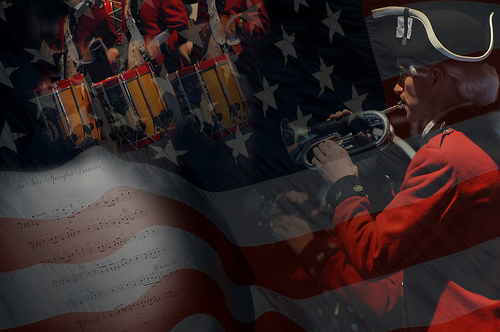Surging interest in U.S. history and government among citizens has recently followed decades of lackluster civic education and test results.
Recent data is dismal. On the 2010 National Assessment of Educational Progress, 24 percent of seniors rated proficient in civics, while fourth and eighth grader proficiency also ranged between 20 and 30 percent. Only 4 percent of seniors tested “advanced.”
These persistent results combined with great energy and interest in the U.S.’s founding has some organizations working to study and counter this negative trend, using innovative teaching technology, research, and classical curricula to draw Americans young and old to a subject which, at its best, teaches not only government machinations, but how to engage as a citizen in a representative republic.
Citizenship and Teachers
The Program on American Citizenship at the American Enterprise Institute, a well-known D.C. think tank, was created in 2010 to explore causes and possible solutions to civic ignorance.
For the survey “High Schools, Civics, and Citizenship,” researchers contrasted social studies teachers against the general public, exploring variances in opinion and preferences. It also compared Democrats and Republicans.
Opinions about what students should learn divided on partisan lines, while attitudes teachers expressed aligned with the public. Eighty-four percent of the public and 83 percent of teachers believe the United States is a “unique country that stands for something special in the world.” The two groups largely agreed students should learn to “respect and appreciate their country, but know its shortcomings.”
Teachers: Test Civics
“These teachers feel very marginalized right now,” said Cheryl Miller, the program manager. “The only thing that counts is math and reading because it gets tested. Over 90 percent [of teachers] said they would like to be part of their states’ accountability and testing regimen.”
Testing not only would highlight the subject’s importance to administrators, students, and parents, but also provide definition for what civics curriculum should include, Miller noted.
“Social studies teachers have a really big role and a very full plate,” she said. “Teachers really are at sea.”
Another AEI report warns defining civics curriculum will be difficult given the public’s party-line divide.
Education Technology: iCivics
Since its 2009 founding by Supreme Court Justice Sandra Day O’Conner, iCivics has created 16 educational online video games and a multitude of teaching materials, and has spread to classrooms in every state.
Karon LeCompte and Brooke Blevins, professors at Baylor University’s School of Education, have conducted the games’ only national, independent study by testing 500 iCivics students to see if they learned anything. Their findings, still under review, suggest students do.
“ICivics takes the foundational principles of our country and even other countries and makes them applicable to students’ lives and help them see civics isn’t just about understanding the constitution, but participating in the community,” Blevins said.
Constitution Gaming
In some of the games, students pretend to run a constitutional law firm, create local government budgets, and stage a presidential campaign.
Although for some it was a steeper learning curve than others, teachers saw more potential once they played and read about the games themselves, Blevins said.
“One of the biggest findings in the research was that teachers matter and [so does] teachers’ ability to take this and adapt it,” Blevins said.
Educating for Self-Government
Hillsdale College promotes civics instruction as central to the well-rounded education necessary for citizens in a democratic republic. The college’s free online Constitution course boasts 275,000 registrants.
“Civics education emphasizes the touchstone of the American founding,” said David Bobb, director of the college’s Kirby Center for Constitutional Studies and Citizenship. “Post-World War II we started transferring more to this term ‘social studies.’ I think if you had to sum up in one line what social studies stands for, it makes the Declaration [of Independence] dead and the constitution living.”
“What we’re trying to do at Hillsdale is stand against that trend but, even more, offer something in its place,” he continued.
Shying away from traditional textbook learning and requiring subjects like Latin, Hillsdale’s high school curriculum has piqued public interest: Schools in every state and 10 countries have bought the “Hillsdale Academy Reference Guide.” Hillsdale is also helping found classical charter schools.
Force of Parents
Bobb said the Tea Party may be partially responsible for resurging interest in American government, but parents are the driving force behind classical schools, wanting to ensure their children understand civics and citizenship better than they do.
“We’re responding to …the hunger we’re observing of people wanting to understand about the founding principles of the country,” said Philip Kilgore, director of Hillsdale’s charter school development team.” They detect in their bones that something is awry. Many of them were never educated sufficiently to understand thoroughly and faithfully what those founding principles are.”
Teaching the Teachers
Hillsdale College’s network of schools not only imparts classical education, but has worked with more than 2,000 teachers over the past two years through its Hoogland Center for Teacher Excellence.
“The Hoogland Center has been a tremendous multiplier effect,” Bobb said. “When you’re turned on to the possibility that there’s really interesting stuff in history and it has a purpose, it can really have a really wonderful transformative effect.”
Classical education produced Western Civilization and the United States, Kilgore said, and hopefully can help rejuvenate it.
“It’s the kind of education that our founders had, without which they would not have been able to do what they did,” he said. “So it’s returning to the time-tested model… Not that this is the ultimate quantifier, but students at these schools have very high test scores.”
Image by Beverly & Pack.




